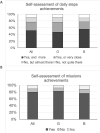iEngage: A digital health education program designed to enhance physical activity in young adolescents
- PMID: 36197890
- PMCID: PMC9534399
- DOI: 10.1371/journal.pone.0274644
iEngage: A digital health education program designed to enhance physical activity in young adolescents
Abstract
iEngage is a modular health education and behavioural change program designed to help adolescents increase moderate to vigorous physical activity (MVPA). The program is delivered through the iEngage app which integrates activity trackers data (Misfit Ray©) within 10 interactive learning modules. Key features include guidance to set goals, self-monitor and assess achievements, and experiential learning via the connected activity trackers which allows for continuous steps recording during the program. iEngage was implemented in two schools over 5 weeks with 10-12 years old adolescents (n = 57) and PA outcomes compared to control group (n = 26). Results show that adolescents successfully set goals and self-assessed achievements during the program, progressing toward higher physical activity (PA) levels as shown by the 30% increase in daily steps through the program (+ 2647 steps/day, P < .001) with boys increasing goals and achievements faster than girls. The consistency in days totalling at least 11,000 steps/day increased from 35% at the start to 48% at the end of the program. The increase in PA is confirmed through the assessment of MVPA during schooldays pre- and post- program via research grade wrist accelerometers in both iEngage and control participants. Contrasting with the control group, MVPA was increased in the week following the program (~+5 min/day, P = .023) in short bouts, particularly during lunch time, recess and after school. This study shows that a digital program integrating activity trackers data, health education, goals setting and self-monitoring of PA, helped young adolescents enhance PA goals, improve achievements and increase MVPA.
Conflict of interest statement
The authors of this manuscript have read the journal’s policy and declare the following competing interests:: All authors have completed the ICMJE uniform disclosure form at www.icmje.org/coi_disclosure.pdf and declare: CD and SL have no competing interests. CC, OG, and KY received a research grant from Australia Diabetes Research Trust to conduct the research. GC is employed at bepatient (an Alira Health company) a digital health company that provided technical support for the integration of the program into the bepatient digital platform. This does not alter our adherence to PLOS ONE policies on sharing data and materials.
Figures






Similar articles
-
Improving Pacific Adolescents' Physical Activity Toward International Recommendations: Exploratory Study of a Digital Education App Coupled With Activity Trackers.JMIR Mhealth Uhealth. 2019 Dec 11;7(12):e14854. doi: 10.2196/14854. JMIR Mhealth Uhealth. 2019. PMID: 31825319 Free PMC article.
-
The challenge of low physical activity during the school day: at recess, lunch and in physical education.Br J Sports Med. 2011 Aug;45(10):813-9. doi: 10.1136/bjsm.2009.068072. Epub 2010 Mar 9. Br J Sports Med. 2011. PMID: 20215489 Clinical Trial.
-
Physical Activity Levels of Chilean Children in a National School Intervention Programme. A Quasi-Experimental Study.Int J Environ Res Public Health. 2020 Jun 23;17(12):4529. doi: 10.3390/ijerph17124529. Int J Environ Res Public Health. 2020. PMID: 32586063 Free PMC article.
-
Interventions to Change School Recess Activity Levels in Children and Adolescents: A Systematic Review and Meta-Analysis.Sports Med. 2020 Dec;50(12):2145-2173. doi: 10.1007/s40279-020-01347-z. Sports Med. 2020. PMID: 33068273
-
How many steps/day are enough? for children and adolescents.Int J Behav Nutr Phys Act. 2011 Jul 28;8:78. doi: 10.1186/1479-5868-8-78. Int J Behav Nutr Phys Act. 2011. PMID: 21798014 Free PMC article. Review.
Cited by
-
Effectiveness of wearable activity trackers on physical activity among adolescents in school-based settings: a systematic review and meta-analysis.BMC Public Health. 2025 Mar 18;25(1):1050. doi: 10.1186/s12889-025-22170-z. BMC Public Health. 2025. PMID: 40102761 Free PMC article.
-
Promoting child and adolescent health through wearable technology: A systematic review.Digit Health. 2024 Jun 11;10:20552076241260507. doi: 10.1177/20552076241260507. eCollection 2024 Jan-Dec. Digit Health. 2024. PMID: 38868368 Free PMC article. Review.
-
Integrating digital health into pediatric obesity management: Current practices and future perspectives.Obes Pillars. 2025 Jun 26;16:100189. doi: 10.1016/j.obpill.2025.100189. eCollection 2025 Dec. Obes Pillars. 2025. PMID: 40688481 Free PMC article. Review.
-
A Digital Educational Intervention With Wearable Activity Trackers to Support Health Behaviors Among Childhood Cancer Survivors: Pilot Feasibility and Acceptability Study.JMIR Cancer. 2022 Aug 17;8(3):e38367. doi: 10.2196/38367. JMIR Cancer. 2022. PMID: 35976683 Free PMC article.
-
Unsupervised Early Detection of Physical Activity Behaviour Changes from Wearable Accelerometer Data.Sensors (Basel). 2022 Oct 28;22(21):8255. doi: 10.3390/s22218255. Sensors (Basel). 2022. PMID: 36365953 Free PMC article.
References
-
- Guthold R, Stevens GA, Riley LM, Bull FC. Global trends in insufficient physical activity among adolescents: a pooled analysis of 298 population-based surveys with 1·6 million participants. The Lancet Child & Adolescent Health. 2020;4(1):23–35. doi: 10.1016/s2352-4642(19)30323-2 - DOI - PMC - PubMed
-
- Australian Government Department of Health. Guidelines for healthy growth and development for children and young people (5 to 17 years). https://www.health.gov.au/sites/default/files/documents/2021/05/24-hour-.... 2021.
-
- Australian Government. Australian Institute of Health and Welfare (2017–2018). https://www.aihw.gov.au/reports/children-youth/physical-activity. Report. 2018.
-
- Cooper AR, Goodman A, Page AS, Sherar LB, Esliger DW, van Sluijs EM, et al.. Objectively measured physical activity and sedentary time in youth: the International children’s accelerometry database (ICAD). Int J Behav Nutr Phys Act. 2015;12:113. Epub 2015/09/18. doi: 10.1186/s12966-015-0274-5 ; PubMed Central PMCID: PMC4574095. - DOI - PMC - PubMed
-
- Ekelund U, Brage S, Froberg K, Harro M, Anderssen SA, Sardinha LB, et al.. TV viewing and physical activity are independently associated with metabolic risk in children: the European Youth Heart Study. PLoS Med. 2006;3(12):e488. Epub 2006/12/30. doi: 10.1371/journal.pmed.0030488 ; PubMed Central PMCID: PMC1705825. - DOI - PMC - PubMed

